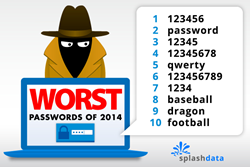Data Privacy Day, recognized each year on January 28, is an international effort focused on protecting privacy, safeguarding data, and enabling trust. Data Privacy Day encourages everyone to weigh the benefits and risks of sharing information, understand what their information can be used for, and take steps to protect themselves and their identities.
 Here are the most common ways people put their personal data at risk:
Here are the most common ways people put their personal data at risk:
- Using weak passwords. Are your passwords part of the worst passwords of 2014 list? The list was compiled by analyzing the passwords found in large data breaches. Do not choose an easy-to-guess password, and do not use the same password for multiple accounts.
- Keeping devices unprotected. If you are separated from your mobile device, you do not want anyone to be able to access all the data from your device, including data stored in your apps. Put your devices out of sight when you walk away from them and password-protect them.
- Sharing too much information online. From including your birthdate, phone number, and address in your social media profiles to posting pictures of when you are on vacation, sharing too much online can give people enough information to access your accounts or your home when you are away. Wait until you’re home from your trip to post pictures.
To help protect against these risks, below are some tips from the national cybersecurity awareness campaign, Stop.Think.Connect.:
- Secure your devices. Take advantage of lock screens, passwords, and fingerprint scanning capabilities to secure your smartphones, tablets, and computers.
- Set strong passwords. Make your passwords hard to guess, and change them regularly.
- Think before you app. Many apps request access to information stored on your mobile device, including your contact lists, pictures, and location data. Determine if you really want to share such information before downloading the app.
- Do business with reputable vendors. Before providing any personal or financial information, make sure that you are interacting with a reputable, established vendor. Attackers may try to trick you by creating malicious websites that falsely appear to be legitimate companies.
- Customize the settings on your accounts. Many accounts include default settings that promote more information sharing. Check your account settings to ensure only the information you want to share is visible to those people you want to share it with. Use the National Cyber Security Alliance’s Check Your Privacy Settings page to get started.
For more tips on safer online behavior and how to protect yourself and your data, visit www.dhs.gov/stopthinkconnect.
Source: Department of Homeland Security
Was this article valuable?
Here are more articles you may enjoy.

 Trump’s Trade War Forces Canada into Decision on Whether to Hit US Autos
Trump’s Trade War Forces Canada into Decision on Whether to Hit US Autos  The Changing ADA Lawsuit Landscape: Things Claims Professionals Need to Know
The Changing ADA Lawsuit Landscape: Things Claims Professionals Need to Know  Tesla Showroom Strikes, Vandalism Sparked by Fury Against Musk
Tesla Showroom Strikes, Vandalism Sparked by Fury Against Musk  Bankruptcy Judge Shoots Down $10 Billion J&J Settlement
Bankruptcy Judge Shoots Down $10 Billion J&J Settlement 